The ProSecure innovation
The ProSecure knee is the only knee, with purely mechanical principles, that locks in flexion while being always free to extend.
The advantages
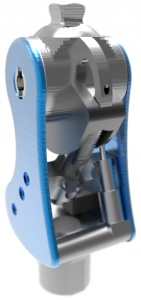
Non contractual view
Optimal Security
 The knee locks and thus secures the patient whenever he puts his weight on his foot up to 15° of angle of flexion. The maximum angle of flexion can be set to avoid the stumbling patient from falling.
The knee locks and thus secures the patient whenever he puts his weight on his foot up to 15° of angle of flexion. The maximum angle of flexion can be set to avoid the stumbling patient from falling.
Ease and reliability

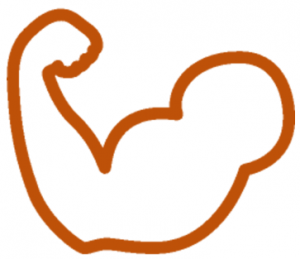 Furthermore, the knee requires very little energy from the patient while not needing any external power source. Purely mechanical, it is robust and easy to maintain and its aleopneumatic shock absorber removes unwanted vibrations. This results in a very fluid and natural gait.
Furthermore, the knee requires very little energy from the patient while not needing any external power source. Purely mechanical, it is robust and easy to maintain and its aleopneumatic shock absorber removes unwanted vibrations. This results in a very fluid and natural gait.
Performance while being affordable
![]()
 Being fully mechnanical, it keeps manufacturing cost low and allows an affordable price.
Being fully mechnanical, it keeps manufacturing cost low and allows an affordable price.
Trustworthy
 From the amputee’s very first steps up to his ultimate activity level autonomy, the ProSecure knee gives trust, accompanies the patient and values his efforts.
From the amputee’s very first steps up to his ultimate activity level autonomy, the ProSecure knee gives trust, accompanies the patient and values his efforts.
Key features
Fully Mecanical
 The ProSecure prosthetic knee brings a fully functional solution relying purely on a simple mechanic principles without any need for electronic controls.
The ProSecure prosthetic knee brings a fully functional solution relying purely on a simple mechanic principles without any need for electronic controls.
Locking by heel loading
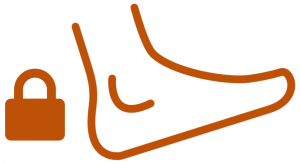 The heart of the knee harbors a freewheel driven by the ground reaction (load line) when the patient touches the ground with his prosthetic foot. It is achieved not only in a straight legged stance but also when the knee is flexed at 15° max.
The heart of the knee harbors a freewheel driven by the ground reaction (load line) when the patient touches the ground with his prosthetic foot. It is achieved not only in a straight legged stance but also when the knee is flexed at 15° max.
Adaptive locking
 This locking mechanism doesn’t require any adjustments and adapts automatically, among other things, to the patient’s weight and to the intensity of the ground reaction. It is either on or off.
This locking mechanism doesn’t require any adjustments and adapts automatically, among other things, to the patient’s weight and to the intensity of the ground reaction. It is either on or off.
Extension always possible
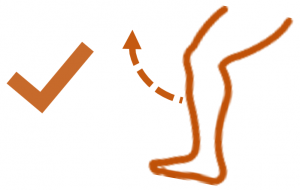 This innovative knee is the only one of its kind to support the patient’s weight by locking in flexion while at the same time allowing the leg to extend. In all situations, the knee allows the leg to extent and therefore can really help a patient to get up from a chair for example.
This innovative knee is the only one of its kind to support the patient’s weight by locking in flexion while at the same time allowing the leg to extend. In all situations, the knee allows the leg to extent and therefore can really help a patient to get up from a chair for example.
Scalable security while learning – maximum angle of flexion
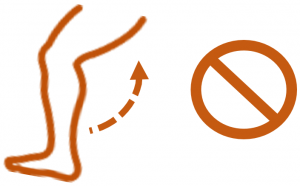 During the learning phase of walking, the security level of the ProSecure Knee can be increased. At first, with a simple adjustment, it allows to walk stiff legged. Progressively, the maximum flexion angle can be extended by the orthotist up to a natural walk. Whatever the ground support, the knee will lock once the maximum flexion angle has been reached, preventing the stumbling patient from falling down.
During the learning phase of walking, the security level of the ProSecure Knee can be increased. At first, with a simple adjustment, it allows to walk stiff legged. Progressively, the maximum flexion angle can be extended by the orthotist up to a natural walk. Whatever the ground support, the knee will lock once the maximum flexion angle has been reached, preventing the stumbling patient from falling down.
Aquacompatible
![]() Made of water resistant material the ProSecure concept allows the knee to be taken in wet environments.
Made of water resistant material the ProSecure concept allows the knee to be taken in wet environments.
Freewheel operation and gait
Behavior and advantages in context
Amputee perspective
 I am a transfemoral amputee with a level of activity of 1 to 2.5 and I am satisfied with the autonomy that ProSecure knee gives me.
I am a transfemoral amputee with a level of activity of 1 to 2.5 and I am satisfied with the autonomy that ProSecure knee gives me.
Natural walk
Each day, I walk in my neighbourhood to shop and socialise. From time to time, I like going out for longer periods on relatively flat grounds. With the ProSecure knee, my gait is natural even when I change rhythm. People can’t tell which is my prosthetic leg when I’m wearing pants. I can choose to cover my prosthesis with foam to mimic my valid leg or choose the color of the side plates.
One way lock
When going around the house and cooking, the support from my prosthetic leg is very stable and reassuring. I am not required to consciously push my hip back to keep my prosthetic leg extended to keep it stable. As soon as my prosthetic foot touches the ground, the knee locks to prevent flexion not only in a straight legged stance but also when the knee is flexed up to 15° as the orthotist told me. The level of responsiveness is adjustable in accordance to my confidence level. After locking and while keeping the ground support, I can still extend my leg up to full extension. A unique feature my prosthesis has which could not be found in a friction knee by my orthotist.
Heel strike absorption
Another useful and comfort element is the preflexion of the knee that absorbs the impact when my prosthetic foot strikes the ground. This preflexion is even available (with a slightly lower effectiveness) in a straight leg gait.
Going down
I can go down slopes and stairs with assurance since the preflexion absorbs the impact. However alternating steps is difficult because my knee does not slowly flex my prosthetic leg while holding my weight as pneumatic or hydraulic shocks do.
Extension absorption
For walking speeds up to 3 to 4 km/h, the knee is very comfortable. A stopper decelerates my swinging leg before full extension, thus asbsorbing impacts and vibrations.
Flexion limitation
Recalling my first steps just after my amputation when I was learning to walk again, I was really reassured and secured by having the flexion of my leg limited. When I was stumbling, the knee prevented me from falling by locking up at a predetermined angle. Furthermore, since it would only lock in flexion, I could re-extend my leg while it was holding my weight. I could then continue my progression seamlessly without any manual interventions as it would be the case with a locking knee. Even today, I occasionally lock my knee in flexion to walk straight leg when my equilibrium is threatened.
Sitting down
With a simple action, I could completely remove the limitation of angle of flexion to be able to sit down. Similarly, if I want to remove some strain on my leg, I could change the limitation angle. This allows me to rest midway on my prosthetic leg while sitting down and guiding myself with the armrests. My prosthetic leg would stay flexed without further effort.
Getting up
It is not easy to get up from a sitting position. The ProSecure knee allows, with a simple push of a button on the front of the knee, to lock the knee in flexion. I can push on my prosthetic leg to get up and the knee would prevent any reverse motion and thus hold my weight if I need to rest or regain balance. Being able to use my two legs to get up really relieves muscle strain. Once up with my leg fully extended or not, I can keep the knee locked in flexion to walk straight leg or unlock it to walk normally. In that manner, switching from a natural gait to a straight leg can be done at will with any angle of flexion of the knee. I can extend my leg even with the lock activated when supporting myself on my prosthetic leg.
Aquacompatible
As a side note, I also really like being able to use my knee in the pool for the rehabilitation sessions.
Professionnal perspective
Kin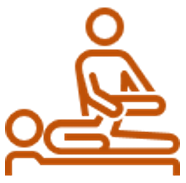 esiotherapist perspective
esiotherapist perspective
My kinesiotherapist tells me I am an easy patient because most of the time my gait is physiological and without an important asymmetry induced in my stance. Therefore, there are few aching muscles to massage.
Prosthetist and Orthotist perspective
My prosthetists and orthotists also say I’m an easy patient because of the low maintenance needed. Once my prosthesis is aligned, adjustments are simple and can be done with standard tools. He starts by setting the sensitivity of the brake according to the ground support push. He also sets the tension of the recall spring to adjust the speed at which the tibial segment is brought back.
When learning to walk again, he sets the intermediate angle of flexion for sitting down and the maximum angle of flexion allowed to minimise the risk of falling. He can also install an optional feature allowing me to adjust the sensitivity level of the brake. In contrast to a braking knee, there are no brake intensity adjustments required because the freewheel has the characteristic of being either on or off and again in one way only.
Conclusion
All in all, even when I am not in good shape or that my equilibrium is precarious, the ProSecure knee is always there to safely allow my full autonomy.
The Prosthesis
After a transfemoral amputation, also known as above the knee amputation, one patient can regain his autonomy by learning to walk again with a prosthesis composed of (from bottom to top) a foot, a pylon (tube), a knee and a socket which links the prosthesis to the living part of the amputated limb called stump.
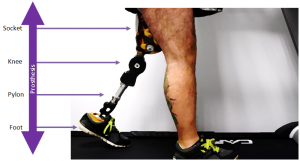
Knee development

Intellectual Property
Patents
The ProSecure knee is protected by the following two patents :
- European patent application EP 2 502 607 under the french patent priority FR 11 52351 of 03/22/2011
- Patent application PCT WO2016/198808 under the french patent priority FR 15 55376 du 06/12/2015
Trademark
The ProSecure® trademark has been filed and registered the 16th of septembre 2014 in class 10 in France under the number 4118332 and for the EU filed the 12th of march 2015 and registered the 17th of july 2015 in class 10 under the number 13821111.
